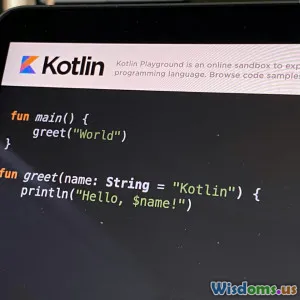
Does Rust Make Your Code More Secure and Reliable
10 min read Exploring how Rust enhances code security and reliability with its unique design and safety features. (0 Reviews)
Does Rust Make Your Code More Secure and Reliable?
Introduction
In the era of ever-increasing cyber threats and the growing complexity of software systems, writing secure and reliable code is more crucial than ever. Developers and businesses alike seek tools and frameworks that not only boost productivity but also guard against vulnerabilities that can lead to catastrophic breaches or failures. Enter Rust — a modern systems programming language that has quickly carved a niche due to its bold promise: enabling programmers to write code that’s both fast and memory-safe without sacrificing concurrency or control.
But does Rust really make your code more secure and reliable? How does it achieve this in ways that older, more established languages cannot? This article dives into Rust’s design philosophy and features, scrutinizes its impact on software security and reliability, and explores why companies and open-source projects are flocking to Rust for mission-critical applications.
The Core Reason for Rust’s Security and Reliability: Ownership and Borrowing
One of Rust’s groundbreaking contributions to programming languages is its ownership model. Unlike languages that rely heavily on garbage collection (like Java) or manual memory management (like C/C++), Rust employs a system where each piece of data has a single owner, and the code enforcer, the compiler, guarantees at compile-time that no invalid pointers or data races exist.
Ownership Explained
Ownership in Rust means that memory deallocation happens automatically when the owner goes out of scope — no manual free calls needed, eliminating a host of common bugs like use-after-free or double free. This also prevents dangling pointers that plague languages like C.
For example:
fn main() {
let s1 = String::from("hello");
let s2 = s1; // s1’s ownership moves to s2
// println!("{}", s1); // This would cause a compile-time error
println!("{}", s2);
}
In this snippet, the compiler prevents accessing s1 post-transfer, protecting from invalid memory access.
Borrowing and References
Rust also introduces the concept of borrowing, allowing functions to reference data without taking ownership. Borrowing comes in two forms: immutable and mutable, and Rust’s strict rules ensure no concurrent mutable borrows happen.
For example:
fn calculate_length(s: &String) -> usize {
s.len()
}
fn main() {
let s = String::from("hello");
let len = calculate_length(&s);
println!("The length of '{}' is {}.", s, len);
}
This ensures references are always valid and prevents race conditions or data corruption.
Unpacking Rust’s Safety Features: The Foundation of Secure Code
Memory Safety without Garbage Collector
Rust achieves memory safety without runtime overhead by ensuring at compile time that every reference is valid. This contrasts languages like Java or Go, where garbage collectors introduce runtime pauses and potential unpredictability, especially in real-time or embedded systems.
In fields such as embedded systems or high-frequency trading where predictability matters as much as safety, Rust’s zero-cost abstractions provide a compelling advantage.
Prevention of Data Races and Undefined Behavior
Data races — situations where two threads access the same variable concurrently, and at least one of the accesses is a write — cause crashes or erratic bugs in concurrent programs. Rust’s ownership and borrowing rules enforce thread-safe access at compile time, drastically reducing subtle concurrency bugs.
For example, the compiler rejects programs like:
use std::thread;
fn main() {
let mut data = vec![1, 2, 3];
let r1 = &data;
let r2 = &mut data; // Compile-time error: cannot borrow `data` as mutable because it is also borrowed as immutable
// Unsafe code to create race condition would be rejected unless explicitly marked unsafe by programmer
}
This compile-time guarantee improves program reliability significantly.
Real-World Evidence: Companies and Projects Embracing Rust for Secure Code
Mozilla’s Servo and Firefox Elements
Rust was originally developed at Mozilla, primarily for security-sensitive projects like the Servo browser engine. Servo aims to build a parallel browser engine with memory safety and high concurrency — demonstrating practical application of Rust’s features. Parts of Firefox itself have been rewritten in Rust, such as the CSS engine "Stylo", leading to fewer security vulnerabilities and better performance.
Cloudflare and Amazon
Cloudflare uses Rust in core components to prevent network-based vulnerabilities. Amazon’s Firecracker — a virtualization technology for microVMs used in AWS Lambda and AWS Fargate — is written in Rust to leverage its safety features, ensuring secure isolation and reliability.
Security Audits and Bug Prevention
Studies show languages with explicit memory management like C/C++ account for roughly 70% of known security vulnerabilities due to memory bugs. By contrast, Rust programs, backed by compiler guarantees, significantly reduce this attack surface.
How Rust Handles Errors Differently
Rust favors explicit, manageable error handling over exceptions, thereby improving reliability:
- It uses Result and Option enums to model recoverable and optional values.
- This makes developers explicitly think about error scenarios.
- Reduces unhandled exceptions that may cause crashes.
For example:
fn divide(dividend: f64, divisor: f64) -> Option<f64> {
if divisor == 0.0 {
None
} else {
Some(dividend / divisor)
}
}
fn main() {
match divide(4.0, 0.0) {
Some(result) => println!("Result: {}", result),
None => println!("Cannot divide by zero."),
}
}
This contrasts with unchecked exceptions in languages like C++ or Java, which can crash runtime if not caught.
Performance and Reliability: Not Mutually Exclusive
A common question arises: does Rust’s safety come with a performance cost? The answer is no — Rust’s zero-cost abstractions mean that the safety checks are done at compile time, with hardly any run-time penalty.
Benchmarks often show Rust matching or even outperforming C and C++ in systems programming tasks.
This unique combination means you get speed against resource limitations and improved security and reliability.
Limitations and Learning Curve
While Rust improves many aspects of code security and reliability, it does come with some challenges:
- Steep learning curve: Mastering ownership, lifetimes, and borrowing is non-trivial.
- Compile times: Comprehensive checks can lead to longer compile times.
- Ecosystem maturity: While growing rapidly, some specialized libraries may still lag behind traditional ecosystems.
However, these trade-offs are often outweighed by its safety benefits in critical applications.
Conclusion
Rust fundamentally redefines how developers approach code safety and reliability by baking security into the language’s very core through its ownership, borrowing, and strict compile-time checks. This removes entire classes of bugs that historically have caused billions of dollars in damages due to exploits, crashes, and unpredictable behavior.
From Mozilla to Cloudflare and AWS, Rust has already proven its worth in the real world, providing powerful, reliable systems while maintaining excellent performance.
As software complexity and the importance of security continue to grow, adopting Rust is more than just a trend — it’s a strategic choice for future-proofing codebases that must be both resilient and trustworthy.
For developers and organizations aiming to build safe and reliable software, learning and adopting Rust promises significant dividends in reliability, safety, and maintainability.
Embrace Rust today — a new era of secure and reliable programming awaits!
Rate the Post
User Reviews
Other posts in Software Development
Popular Posts


















